A Hyperspectral Method for Detection of the Three-Dimensional Spatial Distribution of Aerosol in Urban Areas for Emission Source Identification and Health Risk Assessment
Abstract
1. Introduction
2. Methods
2.1. Overall Observation Scheme Design
2.2. Observation Site
2.3. Instruments and Inversion Approaches
2.4. Spectral Analysis and Inversion of the Aerosol Extinction Profile
2.5. Cluster Analysis
2.6. Health Effect Assessment
3. Results and Discussion
3.1. Result Verification
3.2. Spatial and Temporal Distribution Characteristics
3.2.1. Overall Distribution
3.2.2. Short Time Change
3.3. Health Impact
3.4. Transmission Impact
4. Conclusions
Supplementary Materials
Author Contributions
Funding
Institutional Review Board Statement
Informed Consent Statement
Data Availability Statement
Acknowledgments
Conflicts of Interest
References
- Arfin, T.; Pillai, A.M.; Mathew, N.; Tirpude, A.; Bang, R.; Mondal, P. An overview of atmospheric aerosol and their effects on human health. Environ. Sci. Pollut. Res. 2023, 30, 125347–125369. [Google Scholar] [CrossRef]
- Mack, S.M.; Madl, A.K.; Pinkerton, K.E. Respiratory health effects of exposure to ambient particulate matter and bioaerosols. Compr. Physiol. 2019, 10, 1–20. [Google Scholar] [CrossRef] [PubMed]
- Bari, M.A.; Kindzierski, W.B. Fine particulate matter (PM2.5) in Edmonton, Canada: Source apportionment and potential risk for human health. Environ. Pollut. 2016, 218, 219–229. [Google Scholar] [CrossRef]
- Sharma, S.; Chandra, M.; Kota, S.H. Health Effects Associated with PM2.5: A Systematic Review. Curr. Pollut. Rep. 2020, 6, 345–367. [Google Scholar] [CrossRef]
- Song, Y.; Huang, B.; He, Q.; Chen, B.; Wei, J.; Mahmood, R. Dynamic assessment of PM2.5 exposure and health risk using remote sensing and geo-spatial big data. Environ. Pollut. 2019, 253, 288–296. [Google Scholar] [CrossRef]
- Health Effects Institute. Trends in Air Quality and Health Impacts: Insights from Central, South, and Southeast Asia; Health Effects Institute: Boston. MA, USA, 2025. [Google Scholar]
- Gadi, R.; Shivani; Sharma, S.K.; Mandal, T.K. Source apportionment and health risk assessment of organic constituents in fine ambient aerosols (PM2.5): A complete year study over National Capital Region of India. Chemosphere 2019, 221, 583–596. [Google Scholar] [CrossRef]
- Li, W.; Wang, C.; Wang, H.; Chen, J.; Yuan, C.; Li, T.; Wang, W.; Shen, H.; Huang, Y.; Wang, R.; et al. Distribution of atmospheric particulate matter (PM) in rural field, rural village and urban areas of northern China. Environ. Pollut. 2014, 185, 134–140. [Google Scholar] [CrossRef]
- Zhang, Y.; Shi, Z.; Wang, Y.; Liu, L.; Zhang, J.; Li, J.; Xia, Y.; Ding, X.; Liu, D.; Kong, S.; et al. Fine particles from village air in northern China in winter: Large contribution of primary organic aerosols from residential solid fuel burning. Environ. Pollut. 2021, 272, 116420. [Google Scholar] [CrossRef]
- Shafran-Nathan, R.; Etzion, Y.; Zivan, O.; Broday, D.M. Estimating the spatial variability of fine particles at the neighborhood scale using a distributed network of particle sensors. Atmos. Environ. 2019, 218, 117011. [Google Scholar] [CrossRef]
- Zhao, Y.-F.; Gao, J.; Cai, Y.-J.; Wang, J.-J.; Pan, J. Real-time tracing VOCs, O3 and PM2.5 emission sources with vehicle-mounted proton transfer reaction mass spectrometry combined differential absorption lidar. Atmos. Pollut. Res. 2021, 12, 146–153. [Google Scholar] [CrossRef]
- Gariazzo, C.; Carlino, G.; Silibello, C.; Tinarelli, G.; Renzi, M.; Finardi, S.; Pepe, N.; Barbero, D.; Radice, P.; Marinaccio, A.; et al. Impact of different exposure models and spatial resolution on the long-term effects of air pollution. Environ. Res. 2021, 192, 110351. [Google Scholar] [CrossRef]
- Bai, H.; Wu, H.; Gao, W.; Wang, S.; Cao, Y. Influence of spatial resolution of PM2.5 concentrations and population on health impact assessment from 2010 to 2020 in China. Environ. Pollut. 2023, 326, 121505. [Google Scholar] [CrossRef]
- Wei, F.; Teng, E.; Wu, G.; Hu, W.; Wilson, W.E.; Chapman, R.S.; Pau, J.C.; Zhang, J. Ambient concentrations and elemental compositions of PM10 and PM2.5 in four Chinese cities. Environ. Sci. Technol. 1999, 33, 4188–4193. [Google Scholar] [CrossRef]
- Chen, M.-L.; Mao, I.-F.; Lin, I.-K. The PM2.5 and PM10 particles in urban areas of Taiwan. Sci. Total Environ. 1999, 226, 227–235. [Google Scholar] [CrossRef] [PubMed]
- Masic, A.; Bibic, D.; Pikula, B.; Blazevic, A.; Huremovic, J.; Zero, S. Evaluation of optical particulate matter sensors under realistic conditions of strong and mild urban pollution. Atmos. Meas. Tech. 2020, 13, 6427–6443. [Google Scholar] [CrossRef]
- Badami, M.M.; Tohidi, R.; Aldekheel, M.; Farahani, V.J.; Verma, V.; Sioutas, C. Design, optimization, and evaluation of a wet electrostatic precipitator (ESP) for aerosol collection. Atmos. Environ. 2023, 308, 119858. [Google Scholar] [CrossRef]
- Quan, J.; Huo, J.; Zhang, C.; Pan, Y.; Ma, P.; Liao, Z.; Cheng, Z.; Jia, X.; Wang, Q.; Fu, Q.; et al. High organic aerosol in the low layer over a rural site in the North China Plain (NCP): Observations based on large tethered balloon. Sci. Total Environ. 2024, 915, 170039. [Google Scholar] [CrossRef] [PubMed]
- Shi, Y.; Wang, D.; Huo, J.; Duan, Y.; Lin, Y.; Huang, K.; Fu, Q.; Xiu, G. Vertically-resolved sources and secondary formation of fine particles: A high resolution tethered mega-balloon study over Shanghai. Sci. Total Environ. 2022, 802, 149681. [Google Scholar] [CrossRef]
- Thomas, D.C.; Gosewinkel, U.; Christiansen, M.D.; Frohn, L.M.; Ye, Z.; Massling, A.; Skov, H. Application of Ultralight Aircraft for Aerosol Measurement Within and Above the Planetary Boundary Layer Above the City of Copenhagen. Atmosphere 2025, 16, 39. [Google Scholar] [CrossRef]
- Brooks, J.; Allan, J.D.; Williams, P.I.; Liu, D.; Fox, C.; Haywood, J.; Langridge, J.M.; Highwood, E.J.; Kompalli, S.K.; O’Sullivan, D.; et al. Vertical and horizontal distribution of submicron aerosol chemical composition and physical characteristics across northern India during pre-monsoon and monsoon seasons. Atmos. Meas. Tech. 2019, 19, 5615–5634. [Google Scholar] [CrossRef]
- Zhu, Y.; Wu, Z.; Park, Y.; Fan, X.; Bai, D.; Zong, P.; Qin, B.; Cai, X.; Ahn, K.-H. Measurements of atmospheric aerosol vertical distribution above North China Plain using hexacopter. Sci. Total Environ. 2019, 665, 1095–1102. [Google Scholar] [CrossRef]
- Zheng, T.; Li, B.; Li, X.-B.; Wang, Z.; Li, S.-Y.; Peng, Z.-R. Vertical and horizontal distributions of traffic-related pollutants beside an urban arterial road based on unmanned aerial vehicle observations. Build. Environ. 2021, 187, 107401. [Google Scholar] [CrossRef]
- Li, X.-B.; Peng, Z.-R.; Lu, Q.-C.; Wang, D.; Hu, X.-M.; Wang, D.; Li, B.; Fu, Q.; Xiu, G.; He, H. Evaluation of unmanned aerial system in measuring lower tropospheric ozone and fine aerosol particles using portable monitors. Atmos. Environ. 2020, 222, 117134. [Google Scholar] [CrossRef]
- Hwang, H.; Lee, J.E.; Shin, S.A.; You, C.R.; Shin, S.H.; Park, J.S.; Lee, J.Y. Vertical profiles of PM2.5 and O3 measured using an unmanned aerial vehicle (UAV) and their relationships with synoptic-and local-scale air movements. Remote Sens. 2024, 16, 1581. [Google Scholar] [CrossRef]
- Shukla, P.; Goel, A.; Kumar, V.; Kaur, H.; Malav, V.K.; Rawat, B. A Portable and Power-Efficient Flue Gas Monitoring System for Real-Time Air Quality Measurement. IEEE Sens. J. 2025, 25, 27404–27413. [Google Scholar] [CrossRef]
- Zhang, Y.; Li, Z. Remote sensing of atmospheric fine particulate matter (PM2.5) mass concentration near the ground from satellite observation. Remote Sens. Environ. 2015, 160, 252–262. [Google Scholar] [CrossRef]
- Pan, H.; Yan, J.; Kong, T.; Wang, M. Climatology of low-level aerosol extinction coefficient of different aerosol types and their association with the meteorology during 2007–2021: Insights from the CALIPSO observation over China. Theor. Appl. Clim. 2025, 156, 55. [Google Scholar] [CrossRef]
- Liao, T.; Gui, K.; Li, Y.; Wang, X.; Sun, Y. Seasonal distribution and vertical structure of different types of aerosols in southwest China observed from CALIOP. Atmos. Environ. 2021, 246, 118145. [Google Scholar] [CrossRef]
- Chen, Q.-X.; Huang, C.-L.; Yuan, Y.; Mao, Q.-J.; Tan, H.-P. Spatiotemporal distribution of major aerosol types over China based on MODIS products between 2008 and 2017. Atmosphere 2020, 11, 703. [Google Scholar] [CrossRef]
- Zhang, T.; Zang, L.; Wan, Y.; Wang, W.; Zhang, Y. Ground-level PM2.5 estimation over urban agglomerations in China with high spatiotemporal resolution based on Himawari-8. Sci. Total Environ. 2019, 676, 535–544. [Google Scholar] [CrossRef]
- Zheng, Y.; Che, H.; Xia, X.; Wang, Y.; Wang, H.; Wu, Y.; Tao, J.; Zhao, H.; An, L.; Li, L.; et al. Five-year observation of aerosol optical properties and its radiative effects to planetary boundary layer during air pollution episodes in North China: Intercomparison of a plain site and a mountainous site in Beijing. Sci. Total Environ. 2019, 674, 140–158. [Google Scholar] [CrossRef]
- Fan, W.; Qin, K.; Xu, J.; Yuan, L.; Li, D.; Jin, Z.; Zhang, K. Aerosol vertical distribution and sources estimation at a site of the Yangtze River Delta region of China. Atmos. Res. 2019, 217, 128–136. [Google Scholar] [CrossRef]
- Gupta, G.; Ratnam, M.V.; Madhavan, B.; Prasad, P.; Narayanamurthy, C. Vertical and spatial distribution of elevated aerosol layers obtained using long-term ground-based and space-borne lidar observations. Atmos. Environ. 2021, 246, 118172. [Google Scholar] [CrossRef]
- Sheng, Z.; Che, H.; Chen, Q.; Xia, X.; Liu, D.; Wang, Z.; Zhao, H.; Gui, K.; Zheng, Y.; Sun, T.; et al. Aerosol vertical distribution and optical properties of different pollution events in Beijing in autumn 2017. Atmos. Res. 2019, 215, 193–207. [Google Scholar] [CrossRef]
- Sun, T.; Che, H.; Qi, B.; Wang, Y.; Dong, Y.; Xia, X.; Wang, H.; Gui, K.; Zheng, Y.; Zhao, H.; et al. Characterization of vertical distribution and radiative forcing of ambient aerosol over the Yangtze River Delta during 2013–2015. Sci. Total Environ. 2019, 650, 1846–1857. [Google Scholar] [CrossRef]
- Li, X.; Xie, P.; Li, A.; Xu, J.; Ren, H.; Ren, B.; Li, Y.; Li, J. Study of aerosol characteristics and sources using MAX-DOAS measurement during haze at an urban site in the Fenwei Plain. J. Environ. Sci. 2021, 107, 1–13. [Google Scholar] [CrossRef]
- Gao, C.; Xing, C.; Tan, W.; Lin, H.; Bu, N.; Xue, J.; Liu, F.; Liu, W. Vertical characteristics and potential sources of aerosols over northeast China using ground-based MAX-DOAS. Atmos. Pollut. Res. 2023, 14, 101691. [Google Scholar] [CrossRef]
- Lu, C.; Li, Q.; Xing, C.; Hu, Q.; Tan, W.; Lin, H.; Lin, J.; Zhang, Z.; Chang, B.; Liu, C. A novel hyperspectral remote sensing technique with hour-hectometer level horizontal distribution of trace gases: To accurately identify emission sources. J. Remote. Sens. 2023, 3, 0098. [Google Scholar] [CrossRef]
- Lu, P.; Tuheti, A.; Deng, S.; Li, G.; Liu, J. Spatial Distribution and Inter-City Transport of PM2.5 Concentrations from Vehicles in the Guanzhong Plain in Winter. Atmosphere 2023, 14, 1748. [Google Scholar] [CrossRef]
- Ji, X.; Liu, C.; Wang, Y.; Hu, Q.; Lin, H.; Zhao, F.; Xing, C.; Tang, G.; Zhang, J.; Wagner, T. Ozone profiles without blind area retrieved from MAX-DOAS measurements and comprehensive validation with multi-platform observations. Remote. Sens. Environ. 2023, 284, 113339. [Google Scholar] [CrossRef]
- Wang, Y.; Apituley, A.; Bais, A.; Beirle, S.; Benavent, N.; Borovski, A.; Bruchkouski, I.; Chan, K.L.; Donner, S.; Drosoglou, T.; et al. Inter-comparison of MAX-DOAS measurements of tropospheric HONO slant column densities and vertical profiles during the CINDI-2 campaign. Atmos. Meas. Tech. 2020, 13, 5087–5116. [Google Scholar] [CrossRef]
- Wang, Y.; Dörner, S.; Donner, S.; Böhnke, S.; De Smedt, I.; Dickerson, R.R.; Dong, Z.; He, H.; Li, Z.; Li, Z.; et al. Vertical profiles of NO2, SO2, HONO, HCHO, CHOCHO and aerosols derived from MAX-DOAS measurements at a rural site in the central western North China Plain and their relation to emission sources and effects of regional transport. Atmos. Meas. Tech. 2019, 19, 5417–5449. [Google Scholar]
- Vandaele, A.C.; Hermans, C.; Simon, P.C.; Carleer, M.; Colin, R.; Fally, S.; Merienne, M.F.; Jenouvrier, A.; Coquart, B. Measurements of the NO2 absorption cross-section from 42 000 cm−1 to 10 000 cm−1 (238–1000 nm) at 220 K and 294 K. J. Quant. Spectrosc. Radiat. Transf. 1998, 59, 171–184. [Google Scholar] [CrossRef]
- Serdyuchenko, A.; Gorshelev, V.; Weber, M.; Chehade, W.; Burrows, J.P. High spectral resolution ozone absorption cross-sections—Part 2: Temperature dependence. Atmos. Meas. Tech. 2014, 7, 625–636. [Google Scholar] [CrossRef]
- Thalman, R.; Volkamer, R. Temperature dependent absorption cross-sections of O2–O2 collision pairs between 340 and 630 nm and at atmospherically relevant pressure. Phys. Chem. Chem. Phys. 2013, 15, 15371–15381. [Google Scholar] [CrossRef]
- Fleischmann, O.C.; Hartmann, M.; Burrows, J.P.; Orphal, J. New ultraviolet absorption cross-sections of BrO at atmospheric temperatures measured by time-windowing Fourier transform spectroscopy. J. Photochem. Photobiol. A Chem. 2004, 168, 117–132. [Google Scholar] [CrossRef]
- Rothman, L.S.; Gordon, I.E.; Barbe, A.; Benner, D.C.; Bernath, P.E.; Birk, M.; Boudon, V.; Brown, L.R.; Campargue, A.; Champion, J.P.; et al. The HITRAN 2008 molecular spectroscopic database. J. Quant. Spectrosc. Radiat. Transf. 2009, 110, 533–572. [Google Scholar] [CrossRef]
- Meller, R.; Moortgat, G.K. Temperature dependence of the absorption cross sections of formaldehyde between 223 and 323 K in the wavelength range 225–375 nm. J. Geophys. Res. Atmos. 2000, 105, 7089–7101. [Google Scholar] [CrossRef]
- Chance, K.V.; Spurr, R.J.D. Ring effect studies: Rayleigh scattering, including molecular parameters for rotational Raman scattering, and the Fraunhofer spectrum. Appl. Opt. 1997, 36, 5224–5230. [Google Scholar] [CrossRef]
- Chance, K.; Kurucz, R.L. An improved high-resolution solar reference spectrum for earth’s atmosphere measurements in the ultraviolet, visible, and near infrared. J. Quant. Spectrosc. Radiat. Transf. 2010, 111, 1289–1295. [Google Scholar] [CrossRef]
- Friedrich, M.M.; Rivera, C.; Stremme, W.; Ojeda, Z.; Arellano, J.; Bezanilla, A.; García-Reynoso, J.A.; Grutter, M. NO2 vertical profiles and column densities from MAX-DOAS measurements in Mexico City. Atmos. Meas. Tech. 2019, 12, 2545–2565. [Google Scholar] [CrossRef]
- Liu, C.; Xing, C.; Hu, Q.; Li, Q.; Liu, H.; Hong, Q.; Tan, W.; Ji, X.; Lin, H.; Lu, C.; et al. Ground-based hyperspectral stereoscopic remote sensing network: A promising strategy to learn coordinated control of O3 and PM2.5 over China. Engineering 2022, 19, 71–83. [Google Scholar] [CrossRef]
- Wang, Y.Q.; Zhang, X.Y.; Draxler, R.R. TrajStat: GIS-based software that uses various trajectory statistical analysis methods to identify potential sources from long-term air pollution measurement data. Environ. Model. Softw. 2009, 24, 938–939. [Google Scholar] [CrossRef]
- Kan, H.; Chen, B. Particulate air pollution in urban areas of Shanghai, China: Health-based economic assessment. Sci. Total Environ. 2004, 322, 71–79. [Google Scholar] [CrossRef]
- Shao, H.; Li, H.; Jin, S.; Fan, R.; Wang, W.; Liu, B.; Ma, Y.; Wei, R.; Gong, W. Exploring the Conversion Model from Aerosol Extinction Coefficient to PM1, PM2.5 and PM10 Concentrations. Remote Sens. 2023, 15, 2742. [Google Scholar] [CrossRef]
- Hong, Q.; Liu, C.; Hu, Q.; Xing, C.; Tan, W.; Liu, H.; Huang, Y.; Zhu, Y.; Zhang, J.; Geng, T.; et al. Evolution of the vertical structure of air pollutants during winter heavy pollution episodes: The role of regional transport and potential sources. Atmos. Res. 2019, 228, 206–222. [Google Scholar] [CrossRef]
- Wang, S.; Cuevas, C.A.; Frieß, U.; Saiz-Lopez, A. MAX-DOAS retrieval of aerosol extinction properties in Madrid, Spain. Atmos. Meas. Tech. 2016, 9, 5089–5101. [Google Scholar] [CrossRef]
- Karagkiozidis, D.; Friedrich, M.M.; Beirle, S.; Bais, A.; Hendrick, F.; Voudouri, K.A.; Fountoulakis, I.; Karanikolas, A.; Tzoumaka, P.; Van Roozendael, M.; et al. Retrieval of tropospheric aerosol, NO2 and HCHO vertical profiles from MAX-DOAS observations over Thessaloniki, Greece. Atmos. Meas. Tech. Discuss. 2021, 2021, 1–39. [Google Scholar]
- Wang, Y.; Lampel, J.; Xie, P.; Beirle, S.; Li, A.; Wu, D.; Wagner, T. Ground-based MAX-DOAS observations of tropospheric aerosols, NO2, SO2 and HCHO in Wuxi, China, from 2011 to 2014. Atmos. Meas. Tech. 2017, 17, 2189–2215. [Google Scholar] [CrossRef]
- Zhang, X.; Wu, Y. The Single-Scattering Albedo of Black Carbon Aerosols in China. Atmosphere 2024, 15, 1238. [Google Scholar] [CrossRef]
- Moise, T.; Flores, J.M.; Rudich, Y. Optical properties of secondary organic aerosols and their changes by chemical processes. Chem. Rev. 2015, 115, 4400–4439. [Google Scholar] [CrossRef]
- Hess, M.; Koepke, P.; Schult, I. Optical properties of aerosols and clouds: The software package OPAC. Bull. Am. Meteorol. Soc. 1998, 79, 831–844. [Google Scholar] [CrossRef]
- Dai, Q.; Bi, X.; Liu, B.; Li, L.; Ding, J.; Song, W.; Bi, S.; Schulze, B.C.; Song, C.; Wu, J.; et al. Chemical nature of PM2.5 and PM10 in Xi’an, China: Insights into primary emissions and secondary particle formation. Environ. Pollut. 2018, 240, 155–166. [Google Scholar] [CrossRef] [PubMed]
- Song, Y.-Z.; Yang, H.-L.; Peng, J.-H.; Song, Y.-R.; Sun, Q.; Li, Y.; Sun, Q. Estimating PM2.5 concentrations in Xi’an City using a generalized additive model with multi-source monitoring data. PLoS ONE 2015, 10, e0142149. [Google Scholar] [CrossRef]
- Song, Y.; Xing, C.; Liu, C.; Lin, J.; Wu, H.; Liu, T.; Lin, H.; Zhang, C.; Tan, W.; Ji, X.; et al. Evaluation of transport processes over North China Plain and Yangtze River Delta using MAX-DOAS observations. Atmos. Meas. Tech. 2023, 23, 1803–1824. [Google Scholar] [CrossRef]
- Ou, J.; Hu, Q.; Xing, C.; Zhu, Y.; Feng, J.; Ji, X.; Zhang, M.; Wang, X.; Li, L.; Liu, T.; et al. Analysis of the Vertical Distribution and Driving Factors of Aerosol and Ozone Precursors in Huaniao Island, China, Based on Ground-Based MAX-DOAS. Remote Sens. 2023, 15, 5103. [Google Scholar] [CrossRef]
- Xu, X.; Zhang, H.; Chen, J.; Li, Q.; Wang, X.; Wang, W.; Zhang, Q.; Xue, L.; Ding, A.; Mellouki, A. Six sources mainly contributing to the haze episodes and health risk assessment of PM2.5 at Beijing suburb in winter 2016. Ecotoxicol. Environ. Saf. 2018, 166, 146–156. [Google Scholar] [CrossRef] [PubMed]
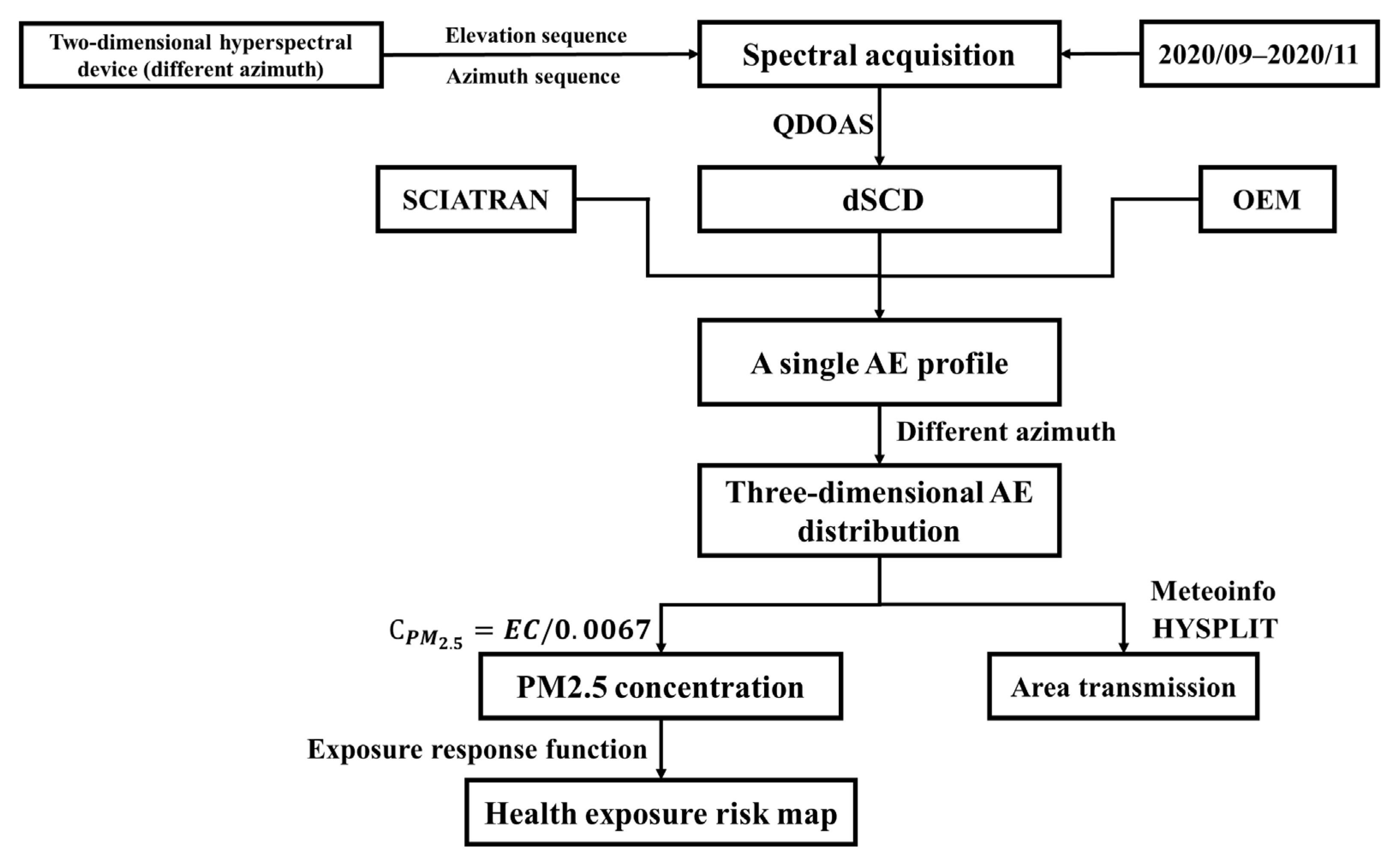

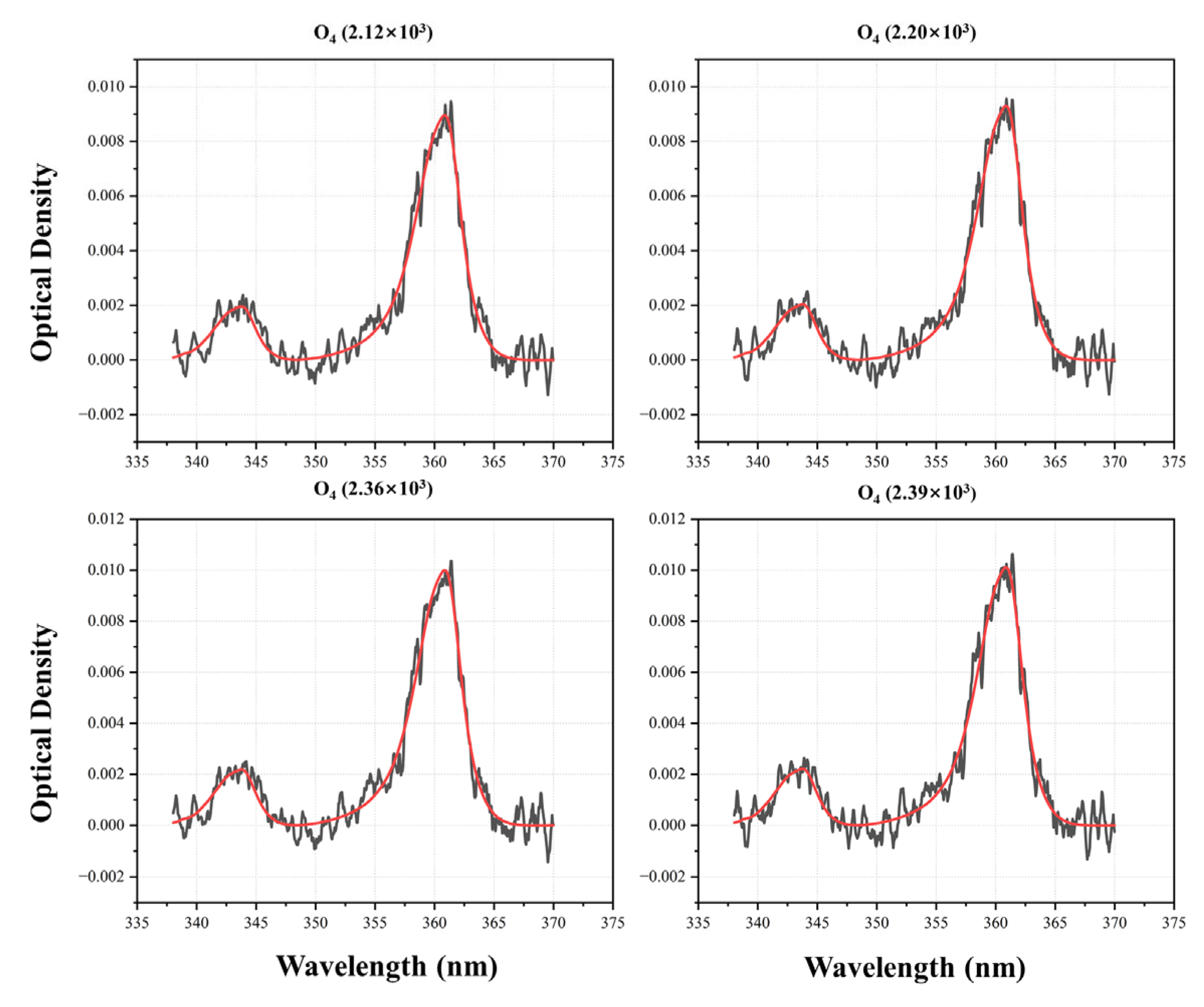

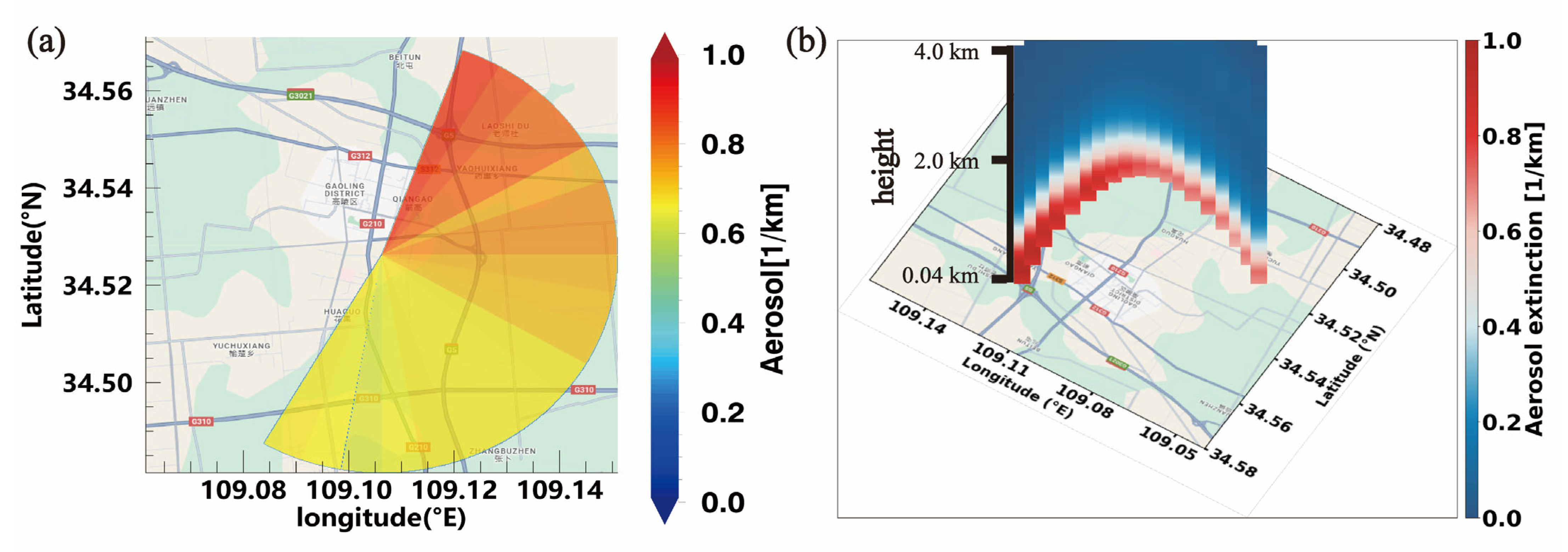
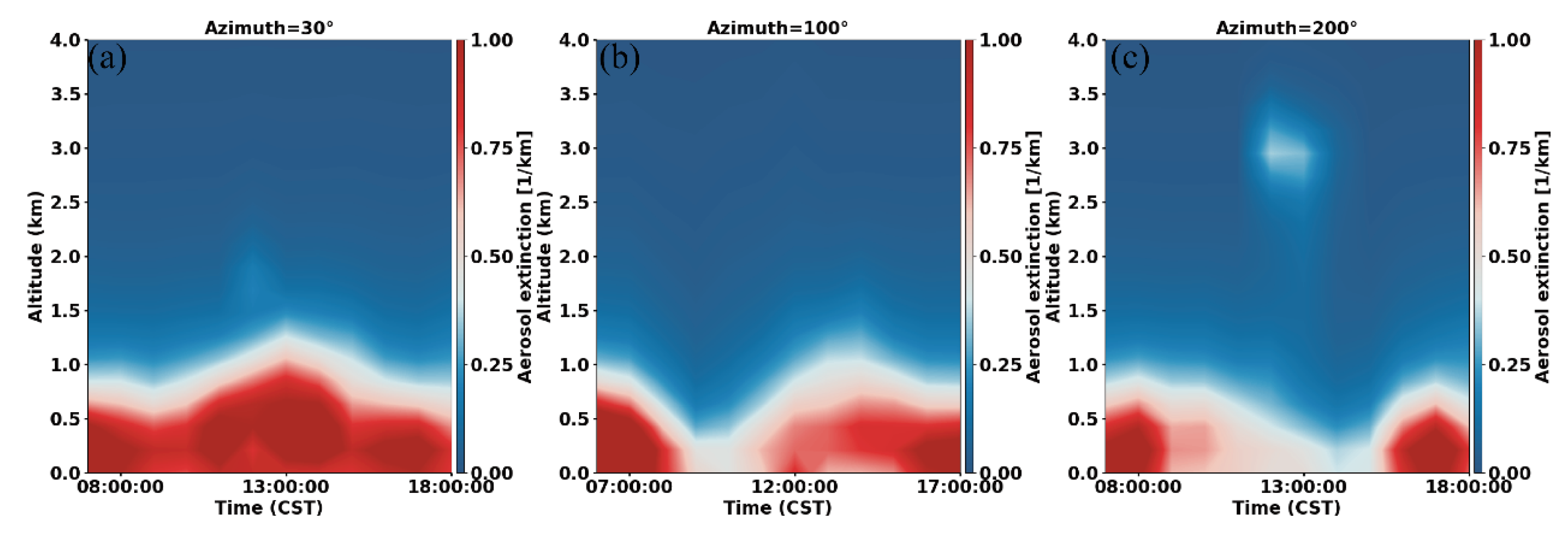
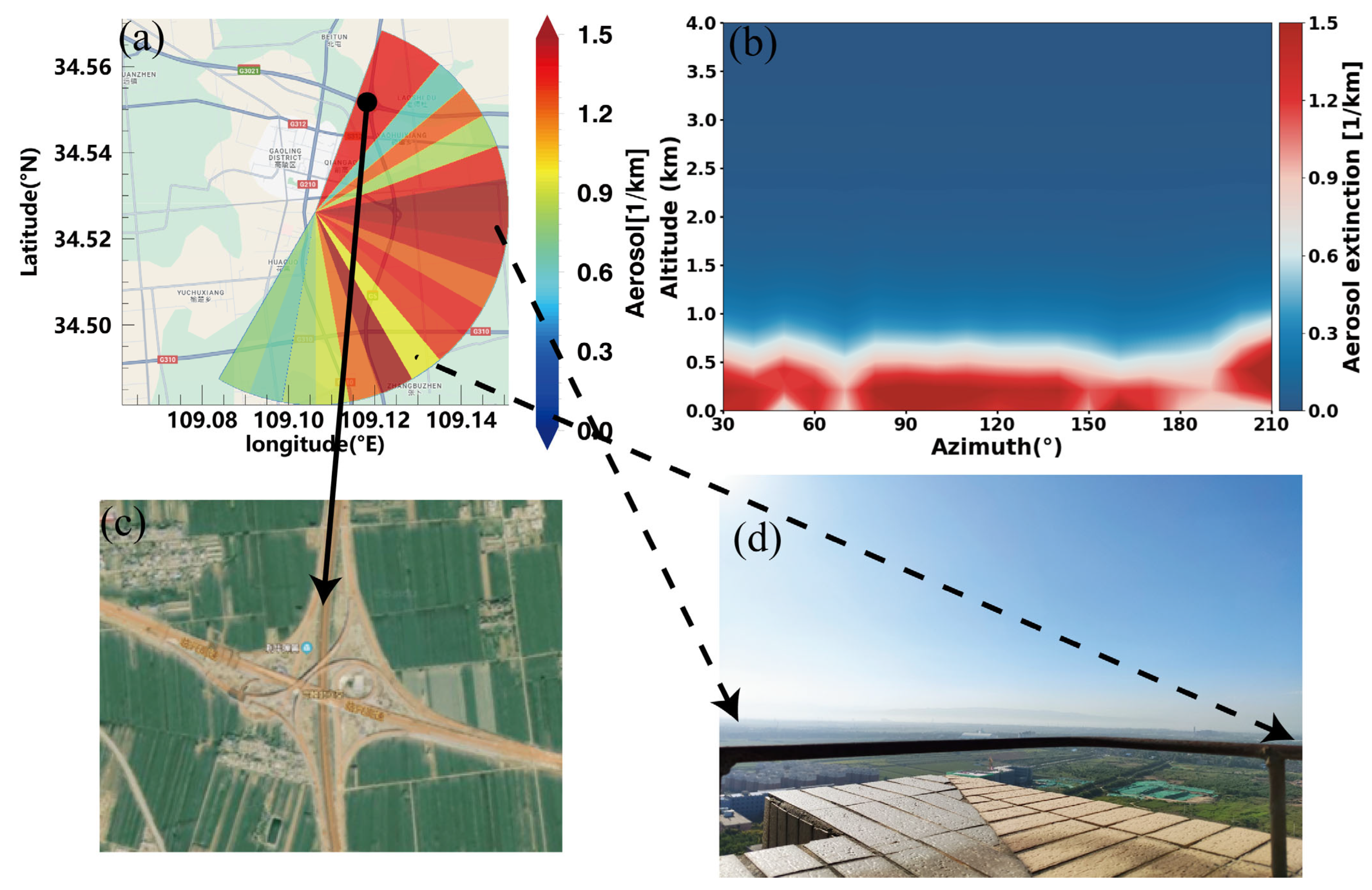
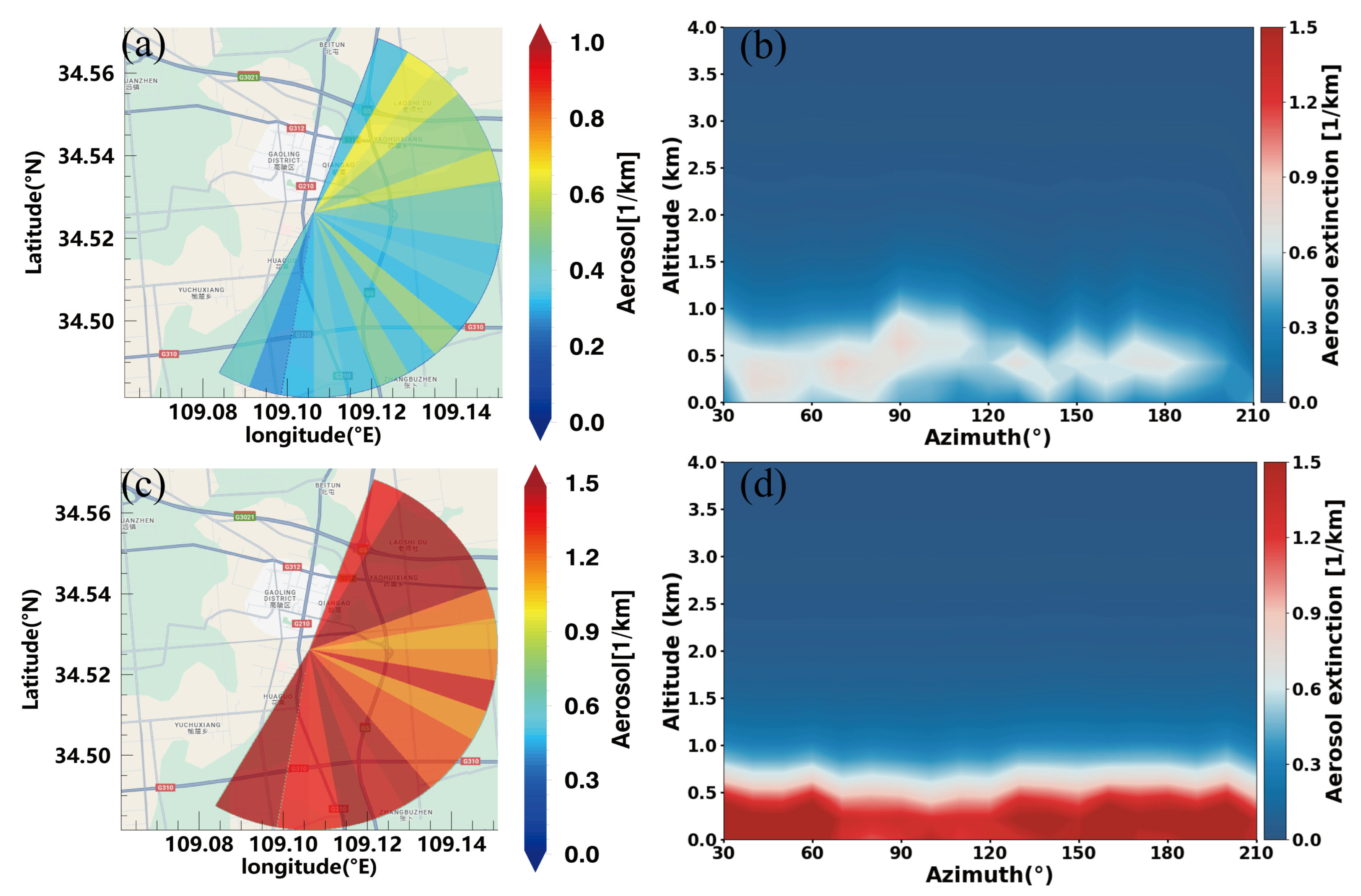
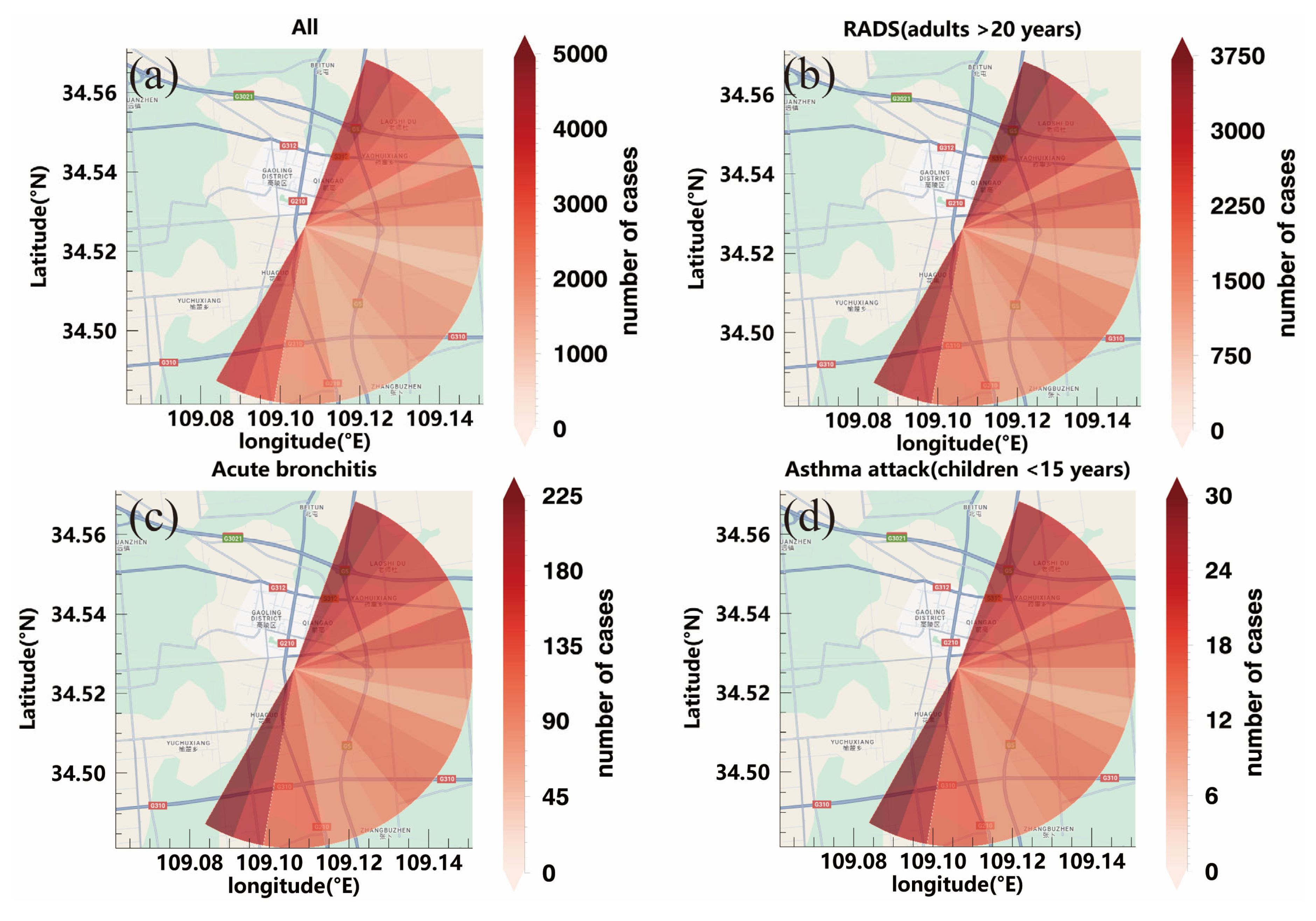
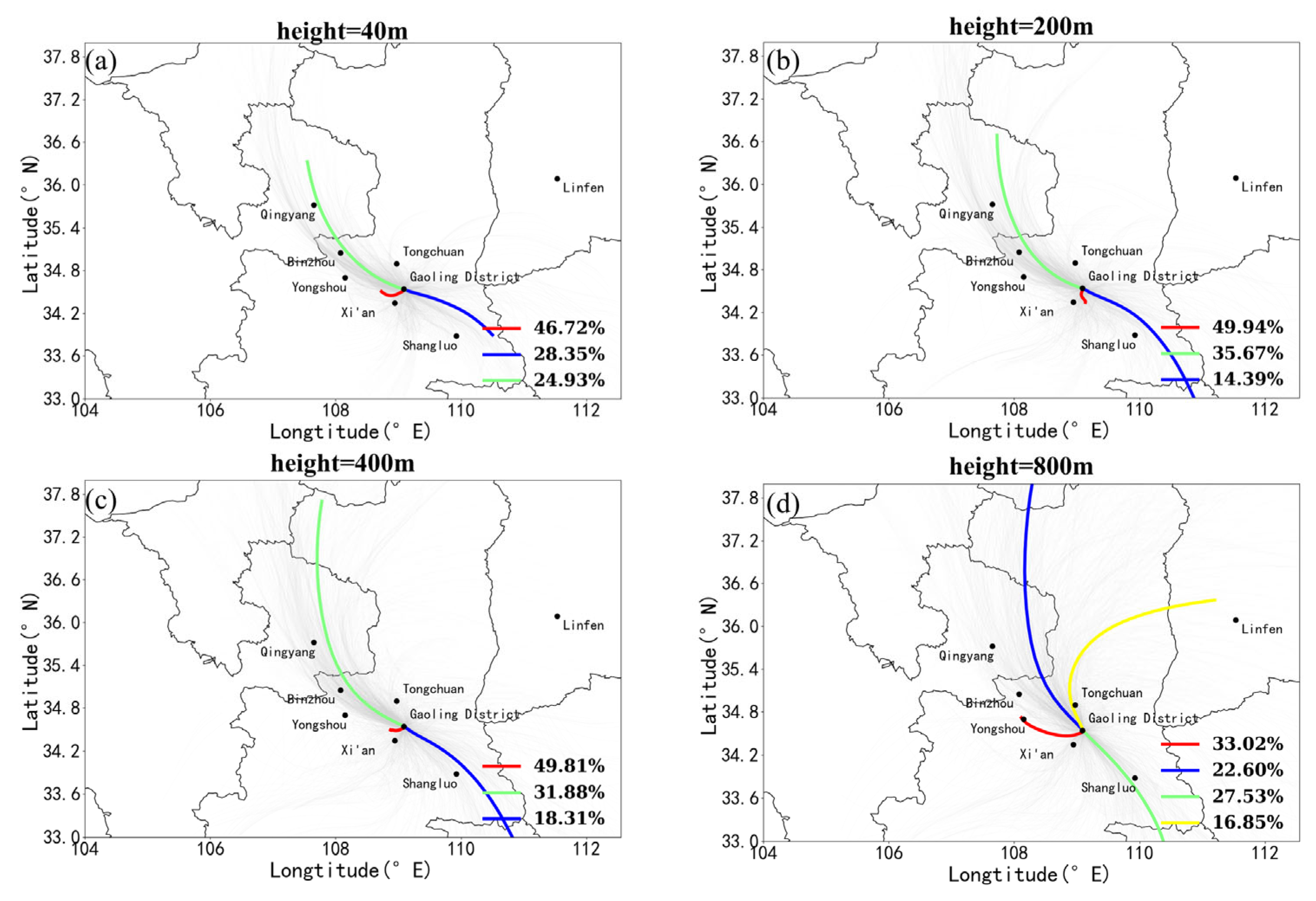
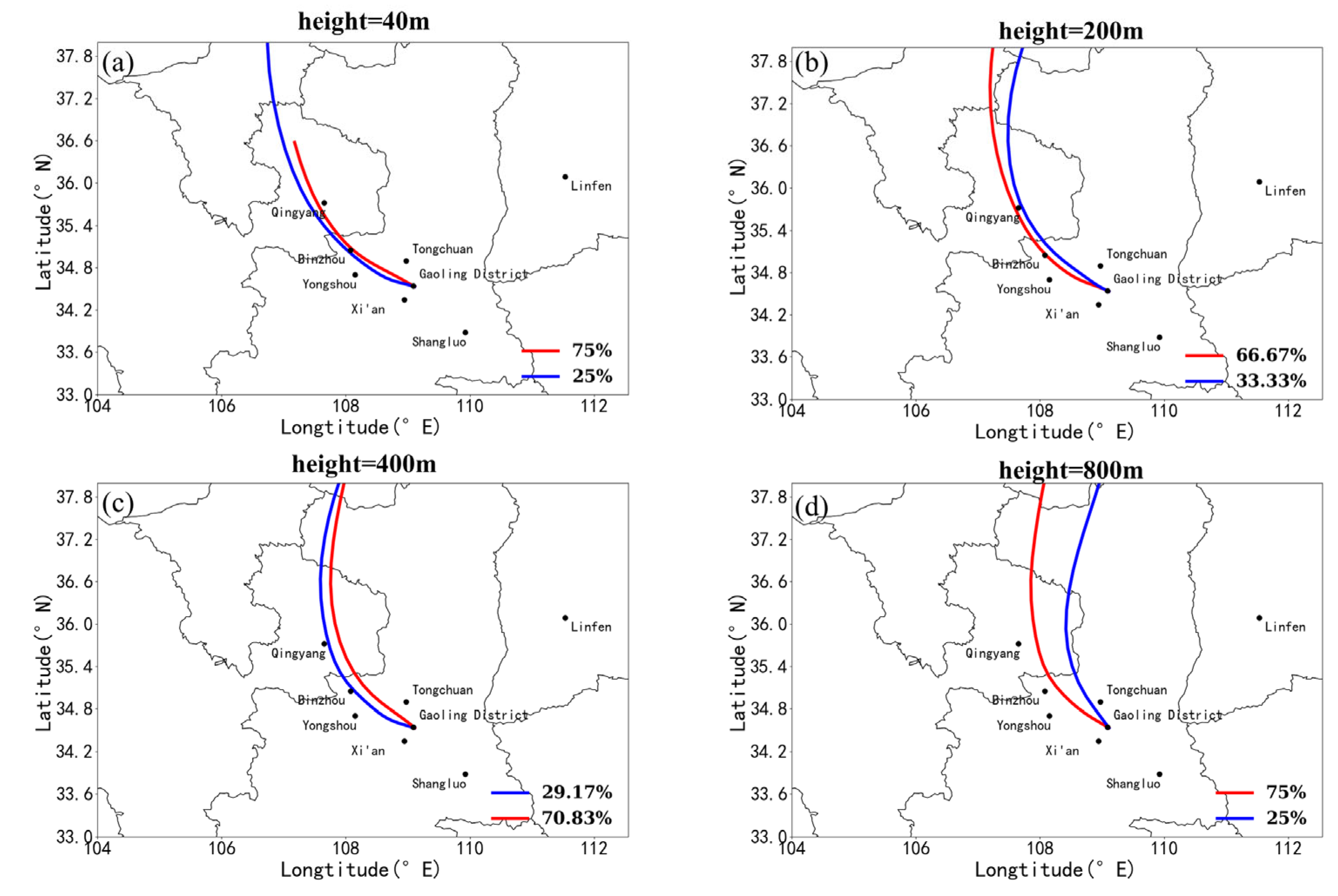
| Date | Mode | Azimuth Angle | Elevation |
|---|---|---|---|
| From 22 September 2020, to 22 November 2020. | hybrid | 30–210° (interval = 10°) | 3°, 5°, 8°, 10°, 30°, 90° |
| Parameter | Data Source | O4 |
|---|---|---|
| Wavelength range | 338–370 | |
| NO2 | 298 K, I0 correction (SCD of 1017 molecules cm−2) [44] | √ |
| NO2 | 220 K, I0 correction (SCD of 1017 molecules cm−2) [44] | √ |
| O3 | 223 K, I0 correction (SCD of 1020 molecules cm−2) [45] | √ |
| O3 | 24 K, I0 correction (SCD of 1020 molecules cm−2) [45] | √ |
| O4 | 293 K [46] | √ |
| BrO | 223 K [47] | √ |
| H2O | 296 K, HITEMP [48] | √ |
| HCHO | 297 K [49] | √ |
| Ring | Calculated with DOAS [50] | √ |
| Wavelength calibration | A high-resolution solar reference spectrum (SAO2010 solar spectra) [51] | √ |
| Polynomial degree | Order3 | |
| Intensity offset | Constant |
| Health Outcome | Number of Cases (Average) | |
|---|---|---|
| Mortality | Long-term | 52 |
| Short-term | 2 | |
| Asthma attack | Children < 15 years | 344 |
| Adults > 15 years | 241 | |
| Chronic bronchitis | 71 | |
| Acute bronchitis | 2652 | |
| Respiratory hospital admission | 16 | |
| Cardiovascular hospital admission | 11 | |
| Outpatient visits—internal medicine | 1022 | |
| Outpatient visits—pediatrics | 108 | |
| RADs (adults > 20 years) | 41,678 | |
| Sum | 46,107 | |
Disclaimer/Publisher’s Note: The statements, opinions and data contained in all publications are solely those of the individual author(s) and contributor(s) and not of MDPI and/or the editor(s). MDPI and/or the editor(s) disclaim responsibility for any injury to people or property resulting from any ideas, methods, instructions or products referred to in the content. |
© 2025 by the authors. Licensee MDPI, Basel, Switzerland. This article is an open access article distributed under the terms and conditions of the Creative Commons Attribution (CC BY) license (https://creativecommons.org/licenses/by/4.0/).
Share and Cite
Xia, S.; Li, Q.; Chen, J.; Zhang, Z.; Hu, Q. A Hyperspectral Method for Detection of the Three-Dimensional Spatial Distribution of Aerosol in Urban Areas for Emission Source Identification and Health Risk Assessment. Atmosphere 2025, 16, 999. https://doi.org/10.3390/atmos16090999
Xia S, Li Q, Chen J, Zhang Z, Hu Q. A Hyperspectral Method for Detection of the Three-Dimensional Spatial Distribution of Aerosol in Urban Areas for Emission Source Identification and Health Risk Assessment. Atmosphere. 2025; 16(9):999. https://doi.org/10.3390/atmos16090999
Chicago/Turabian StyleXia, Shun, Qihua Li, Jian Chen, Zhiguo Zhang, and Qihou Hu. 2025. "A Hyperspectral Method for Detection of the Three-Dimensional Spatial Distribution of Aerosol in Urban Areas for Emission Source Identification and Health Risk Assessment" Atmosphere 16, no. 9: 999. https://doi.org/10.3390/atmos16090999
APA StyleXia, S., Li, Q., Chen, J., Zhang, Z., & Hu, Q. (2025). A Hyperspectral Method for Detection of the Three-Dimensional Spatial Distribution of Aerosol in Urban Areas for Emission Source Identification and Health Risk Assessment. Atmosphere, 16(9), 999. https://doi.org/10.3390/atmos16090999







